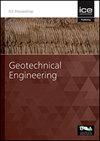不同应力水平下泥炭的剪切特性
IF 1.7
4区 工程技术
Q3 ENGINEERING, GEOLOGICAL
Proceedings of the Institution of Civil Engineers-Geotechnical Engineering
Pub Date : 2023-01-03
DOI:10.1680/jgeen.22.00058
引用次数: 0
摘要
在这项研究中,进行了一系列固结、不排水的三轴压缩试验,研究了1.65 m深度的泥炭样品在10.4 kPa至40.5 kPa的不同应力水平下的剪切行为。在固结阶段,三轴试验专门研究了泥炭在低应力水平下的各向同性压缩性,与文献中可用的测径仪试验数据一致。随后的三轴剪切阶段结果表明,大部分试验数据未能达到张力断线(q/p ' = 3),这表明偏离应力可能比泥炭土中纤维和木材的张力更能代表颗粒间的联系。对于泥炭,膜修正对泥炭剪切抗力的影响是应变相关的;一般在10%剪切应变范围内较小,在10%剪切应变范围以上显著。泥炭的临界状态线是基于最大曲率法确定的,其中Mohr-Coulomb模型难以确定泥炭的摩擦角。在泥炭记录的数据中,78%的数据落在30 ~ 60度范围内,忽略低于10 kPa的点时,这一数字增加到90.4%;由于传统三轴试验装置、试样制备等方面的限制,以往在极低应力水平(小于10kPa)下的试验数据可能不够可靠。此外,有机质含量对泥炭剪切性能也有重要影响。一般来说,当有机质含量超过75%时,泥炭的偏应力表现为有机土,反之,泥炭的偏应力表现为矿质土。在有机含量高于75%的泥炭样品中,直接剪切箱试验给出的抗剪强度估计高于三轴剪切试验,但并不一定准确——直接剪切机制仅在样品中心起作用,而三轴剪切可以剪切整个样品。本文章由计算机程序翻译,如有差异,请以英文原文为准。
Shear behaviour of peat at different stress levels
In this study, a series of consolidated, undrained triaxial compression tests were conducted to investigate peat shear behaviour on samples from 1.65 m depth when subjected to different stress levels from 10.4 kPa to 40.5 kPa. At the consolidation stage, the triaxial test specifically investigated the peat isotropic compressibility at low stress levels, showing an agreement with oedometer test data available in literature. The subsequent triaxial shearing stage results show most of the test data failed to reach the tension cut-off line (q/p’ = 3), which indicated that the deviator stress may represent more of an interparticle connection than the tension of fibres and woods in peaty soils. For peat, the membrane correction effect on peat shear resistance is strain dependent; generally, small within 10% shear strain, but becomes significant above 10% shear strain. A critical state line for peat was determined based on the maximum curvature approach, where the Mohr-Coulomb model has difficulty in determining the friction angle for peat. Of the data recorded for the peat, 78% fell within the range of 30 to 60 degrees, increasing to 90.4% when ignoring points lower than 10 kPa; the previous test data for very low stress level (less than 10kPa) might not be sufficiently reliable due to limitations of conventional triaxial testing apparatus, specimen preparation and etc. In addition, organic content also plays an important role on the peat shear behaviour. In general, when the organic content exceeds 75%, the deviator stress behaves like organic soils, otherwise, the peat behaves more like a mineral soil. In peat samples with organic content higher than 75%, the direct shear box test gives higher estimates of shear strength than the triaxial shear test, but not necessarily accurate — the mechanism of direct shear acts only at the centre of a specimen, while triaxial shear can shear throughout the specimens.
求助全文
通过发布文献求助,成功后即可免费获取论文全文。
去求助
来源期刊
CiteScore
4.40
自引率
4.50%
发文量
68
审稿时长
3 months
期刊介绍:
Geotechnical Engineering provides a forum for the publication of high quality, topical and relevant technical papers covering all aspects of geotechnical research, design, construction and performance. The journal aims to be of interest to those civil, structural or geotechnical engineering practitioners wishing to develop a greater understanding of the influence of geotechnics on the built environment.

 求助内容:
求助内容: 应助结果提醒方式:
应助结果提醒方式:


